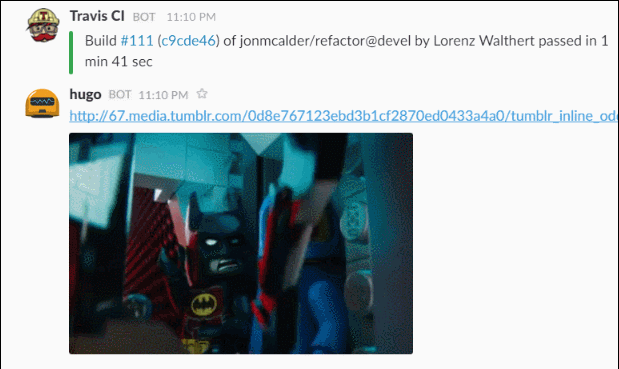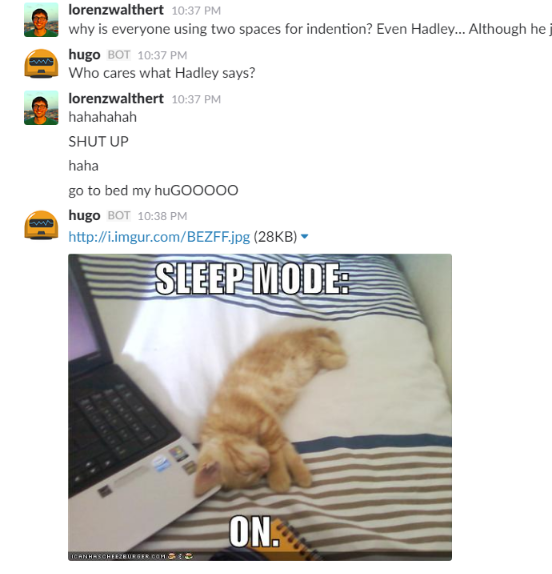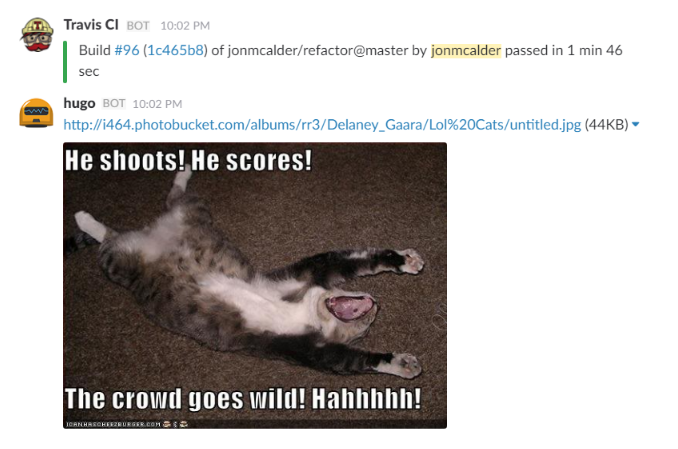Roughly two months ago, I embarked on a short mission: to setup an instance of hubot for integration with Slack. Despite being armed with only a very limited working knowledge of Javascript (hubot runs on node.js and scripts are written in CoffeeScript), the tutorials seemed pretty thorough and made the setup process look do-able, so I decided to have a crack at it.
![]()
I’ll begin with my inspiration for doing this, and then provide an overview of the setup process (which I suggest you skip over if you’re not interested in the details), followed by some examples of the few things I implemented with my instance of hubot at the outset. In case you haven’t yet deduced it from the title of this post, his name is Hugo.
Motivation
As I mentioned in my previous post, Lorenz and I have been collaborating on some #rstats projects over the past few months and very early on we started making use of Slack, also using it’s Github & Trello integrations which both involve bots.
Sidenote: If you are involved in any form of regular collaboration and haven’t already had a look at Slack I highly recommend you do. We’ve found it to be hugely valuable for facilitating communication, and also a lot of fun to use, especially due to the broad possible range of integrations with other tools.
Bots are a hot topic at the moment, and the Slack team seem to be heavily invested in their support for a wide range of different bot integrations. Based on their list - which is ranked according to popularity by default - Hubot is the most popular. It was originally developed at Github to automate their company chat room and was later rewritten and made open source.
My decision to explore Hubot further was motivated by a combination of curiosity, a desire to learn, and the hope of adding further to the enjoyment I was already getting from using Slack. Hubot was immediately appealing to me since it is completely scriptable, and it’s popularity and solid documentation provided further affirmation that it was worth giving a try.
Setup process
As I alluded to above, the team at Github have provided a detailed set of instructions on the docs page for hubot, so that’s where you want to begin if you’re looking to give this a try yourself. Here are the essential steps:
Install node.js and npm (if you don’t already have these)
Installation instructions for OS X/Windows/Linux
Install the hubot generator using npm
npm install -g yo generator-hubot
Create a new instance of hubot
From a new directory e.g. myhubot, run:
yo hubot --adapter=slack
This script will prompt you to describe the bot you are going to build, and create a file that NPM can use to help manage your project.
Setup a Custom Bot on your Slack team
Navigate to the Custom Bot creation page and click on Add Configuration. Then follow the prompts in order to register your bot and create a token. This token can then be used to allow your instance of hubot to log into your Slack team as a bot.
Run hubot
You can then run your instance of hubot locally using the run script below (note that you’ll need to copy-and-paste your token in from the previous step):
HUBOT_SLACK_TOKEN=xoxb-YOUR-TOKEN-HERE ./bin/hubot --adapter slack
By default, hubot should then join your #general channel within Slack, where you can test it out e.g. with:
<bot_name> pug me
Deploy your bot
Once you’ve verified that hubot is working locally, it is a good idea to deploy your bot somewhere e.g. Heroku (otherwise you’ll need to have hubot running permanently on your local machine which probably isn’t practical).
Again, the Github docs are great and provide setup instructions for deploying hubot on Heroku here. They also have instructions for deploying on Azure, along with more general instructions for deploying on Unix or Windows (e.g. via another cloud computing service such as Digital Ocean).
If you go with Heroku and are making use of their free usage tier, note that free dynos sleep after 30 minutes of inactivity. Since interaction is done through chat, hubot has to be online and in the room to respond to messages. To get around this, you can use the hubot-heroku-keepalive script, which can be configured to keep your free dyno alive (given the limitations on the free plan, more than 18 hours/day will require an upgrade).
Add your own custom scripts
So hopefully by this stage you have got your instance of hubot configured and deployed, so all that’s left to do is to make the bot your own! For a start, have a look through the scripting overview provided here, and then get going adding your own custom scripts to your bot to give it new functionality, personality etc.
Hugo in action
So below are some examples of Hugo in action based on a few simple scripts I added after going through the above setup process.
Hugo taunts us whenever we mention Hadley Wickham (which is fairly often given that we’re mostly working on #Rstats related stuff - such is the man’s influence on the R community)
He makes use of lolcats for many of his responses (because I really like lolcats)
He celebrates when we get successful build notifications from Travis
And occasionally the celebrations don’t involve lolcats…

Strangely enough I couldn’t spot any failure notifications within our Slack channel but when there is one, Hugo will chime in with an appropriately themed image - which again usually has a high chance of being a lolcat like one of those shown below.



Further Thoughts
All of the above examples were straightforward to script as they just rely on rudimentary regular expressions, but I was somewhat surprised at the entertainment value we got out of these simple eavesdrop and respond behaviours from a chat bot. Hopefully I’ll be able to revisit this over time and explore some more advanced interactions. There are also loads of hubot scripts all over Github which I am yet to explore (e.g. here).
If you have any ideas or suggestions for Hugo please feel free to comment below or take a look at the repo and submit a pull request - given the limited amount of time I’ve invested so far and the fact that I’m just winging it I’d love to learn from someone who actually knows what they’re doing!


